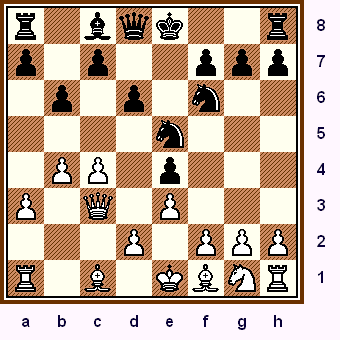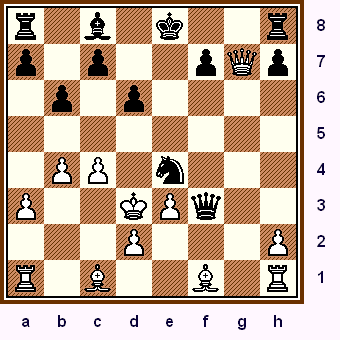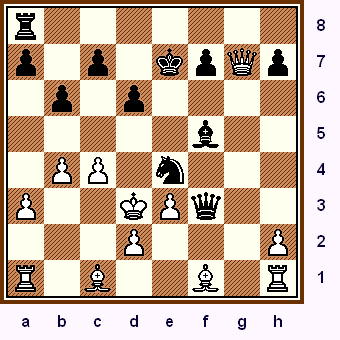"The Curious Case of The Missing Mate" |
|
By now - you probably have heard of the player ... who champions the Black pieces here. (Wang Hao)
I went over this game one Sunday - at chess club, with a few friends. When someone - at chess club - asked me to annotate this game for my website, at first I was very much against the idea. Then I thought that I could kill many birds ... with just one stone. (An annotated game; the next installment of my opening school; it was so tactical, it could easily be a part of that series; it could also be part of my series of "The Anatomy of a Chess Trap" as well. AND ... if this contest had ended (in mate) before move 25, it would have also been one of the more brilliant miniatures of recent times.) So I decided to do it. |
Click HERE to see an explanation of the symbols that I use when annotating a chess game. [replay]
|
|
|
"The Curious Case of The Missing Mate."
First of all ... I must sing this player's praises. (Wang Hao) It is very likely that he is the next big chess prodigy that we all have been waiting for. (He won this event, [more] as well as several others. Barely sixteen, his future holds almost unlimited promise.)
In this game, Rogers plays a line he has used before ... but simply gets carried away. (Opening lines before he completes his development.) And he is punished ... in a truly extraordinary fashion. But the story here is as much as what was missed ... as anything else.
*************************************************************************************************************************
1.c4 e5;
2.Nc3 Nf6; 3.Nf3 Nc6;
A standard English Opening, The Four Knight's Variation.
4.e3,
Already a little unusual, but nothing terribly so, the move d3 led to a reversed Sicilian for White.
(But with an extra tempo.)
[ Normally, White plays g3 in this position.
For example:
4.g3 Bb4; 5.Bg2 0-0;
6.0-0 e4; 7.Ng5 Bxc3;
8.bxc3 Re8; 9.d3,
Actually the older and more reliable continuation. (In post-2000, many masters seem
to prefer 9.d3 in this particular position.)
*** *** *** *** *** *** *** *** *** *** *** *** *** *** *** *** *** *** *** *** *** *** *** *** ***
( White can also try: 9.f3!? e3!? ; 10.d3 d5 ;
with good play for Black.
E.g., GM G. Kasparov - GM A. Karpov; The 34th World's Champ.
(K-K IV)
(Game #2) / Seville, ESP; 1987. {Black won a nice game in under thirty-five
total moves.} )
*** *** *** *** *** *** *** *** *** *** *** *** *** *** *** *** *** *** *** *** *** *** *** *** ***
9...exd3; 10.exd3 d6;
11.Rb1 h6; 12.Ne4,
"+/=" 12...Nxe4;
The end of the column.
13.Bxe4 Ne5; 14.f4! Nxc4;
15.f5, "~"
("Compensation?")
"White has just enough for the Pawn."
- GM Nick de Firmian
GM H. Mecking - IM L. Tan; /
(FIDE) Interzonal Tournament /
Petropolis, BRA; 1973. (1-0)
{White won a nice game, in just 33 total moves.}
[ See MCO-14, beginning on page # 661. (All columns.)
Especially see column # 01, page #
666, and note # (b.). ]
]
4...Bb4;
('!?')
The most popular move in the database, Black can also play his KB to e7, or even try a combination of ...g6 and ...d6. (KID formation.)
This is a very active move, yet I am not sure if I approve this line ...
or would consider playing it myself.
(I like my Bishops too much!)
[ After the moves:
(>/=)
4...Be7;
5.d4 exd4;
6.Nxd4!? 0-0; 7.Be2 d5;
both sides seem to have a 'normal'
position ... and fairly good play.
J. Smejkal - E. Prandsetter; CSR-ch /
Marianske Lazne /
1978.
{A long, tough game ... which was eventually drawn in sixty-one total moves.}
]
5.Qc2!?,
While it might seem unusual to bring the Queen out this early, this is actually the main line, and by far the most popular move for White in this position. (According to the database.)
I would have thought that d2-d4 was correct here. (This is a line, but White's results have not exactly been stellar with this continuation. Perhaps this is because Black can exchange on c3, and play to exploit the doubled Pawn complex.) The first party can also try Nd5!? in this position ... but that leads to a completely different type of game.
[ White could also try the line:
5.Nd5!? e4!?; 6.Ng1!? 0-0;
7.a3, "~" ("+/=" ?)
with unusual and complex play.
GM V. Fillipov - GM L. van Wely;
/
(FIDE) World Chess Champ. (K.O.)
/
2.6 / Tripoli,
Libya; 2004. (1-0)
{White won a nice game in just 27 total, overall moves.}
]
5...d6;
A very solid and common sense sort of move ... which cannot be bad, even though an older pamphlet/book awards this move a dubious appellation. ('?!')
According to the database, Black can (and should) castle here ... which is (by far) the most popular continuation for the second player at this point.
[ Black can also play:
(>/=) 5...0-0; 6.Nd5 Re8;
7.Qf5!? d6; 8.Nxf6+ Qxf6;
9.Qxf6 gxf6; 10.a3 Bc5;
11.b4 Bb6; 12.Bb2 a5;
13.b5 Ne7; 14.Be2,
"+/="
According to two books - and also confirmed by Fritz - White has a very solid edge in this position.
GM S. Agdestein - GM J. Timman; SWIFT Rapid Tournament (open?) /
Brussels, BEL;
1992. (1-0, 56 m.) ]
6.a3,
(Maybe - '!?')
Seemingly premature - but to be fair, this is also 'book' as well as the most popular move according to the database.
(Although there has not been a great deal of GM experience in this line.)
[ (>/=) 6.d3, "=" ]
6...Bxc3;
It would be inconsistent to retreat here - and this would have allowed White to gain a rather substantial advantage from the opening phase of the game.
7.Qxc3,
Seemingly the only move - both the DB and Fritz agree on that.
[ </= 7.dxc3?! e4; 8.Nd2 Qe7; "=/+" ]
7...e4;
Black must play this now, otherwise White will prevent this try or get in d2-d4, when this Pawn advance won't be effective.
8.Ng1!?,
(hmmm) (A TN?!?)
If a student had played this, I would have awarded at least one question mark ... and simply considered this a very bad idea. However, since a GM did this, we have to stop and ask ourselves why.
# 1.) Did I. Rogers want to get his young and inexperienced opponent out of book?
(This is possible.)
# 2.) This Knight retreat is a pretty standard idea in many of the lines of the English.
So perhaps the GM truly
believed this to be best - or at least a playable - move
for White in this position.
8.Nd4 has also been played here, but there is only a literal handful of games in the DB with this particular position.
[ Perhaps slightly better was:
(>/=) 8.Nd4!? Ne5;
"~" ("=/+")
with a playable position for both sides.
(Fritz shows a slight edge for Black here.)
S. Agdestein - R. Fillingham; Namses Open, 1995. (1-0, 48 moves.) ]
8...Ne5!;
Not at all the most obvious move here ... Black seeks to discourage his opponent from playing d2-d4 and also obtain a bind on the light squares as well.
[ The second party could also try:
8...Bf5!?; 9.d4!? exd3;
10.Nf3! 0-0; 11.Bxd3,
"~"
when Black might be slightly better due to his lead in development. (Line by Fritz)
]
9.b4!?,
{premature?}
Rogers expands on the Queenside ...
which is a standard idea in this particular opening. However, here the move is slightly risky, as White is falling
dangerously behind in his overall development. (Maybe '?!')
[ Possibly safer was:
(>/=)
9.d4 exd3;
10.Bxd3 0-0;
"=/+"
when Black is only a little bit better here.
]
9...b6!;
{See the diagram - just below.}
No free rides for White, Black prevents his opponent's idea of c4-c5.
(Hao also prepares a possible fianchetto of his QB.)
************************************
|
|
************************************
r1bqk2r/p1p2ppp/1p1p1n2/4n3/1PP1p3/P1Q1P3/3P1PPP/R1B1KBNR w
At this point, we should stop and take a look at the position and try to assess exactly what is going on in this strange game.
[ 9...Bf5; "=/+" was also good for Black. ]
10.f4?,
(ugh)
Without question, this is both premature and wrong for White.
(Maybe - '??')
----> The only real question is how does a GM play such a move?
I think the best answer lies in the fact that White did not appraise the positions in this game correctly, and possibly missed either's Hao's sixteenth or eighteenth moves during his OTB calculations.
[ Better was: >/= 10.Bb2 Bf5!?; 11.Be2 0-0; 12.f4!; "~" with some play. ]
Since all that White has developed here is the Queen, Black is more than happy to open lines!
10...exf3;
11.Nxf3, {Box?}
This move is probably forced, the alternatives will nearly lose on the spot for White.
[ Even worse for White was:
</= 11.gxf3? Ne4!;
12.Qd4,
This is best or forced.
(After the inferior continuation: </= 12.fxe4? Qh4+; 13.Kd1
Qxe4; "-/+"
White loses {more} material.)
12...Qh4+; 13.Kd1, Once more, the only move.
(Of course not: </= 13.Ke2?? Qf2+; 14.Kd1 Qxf1+; 15.Kc2 Nf6; ("-/+") etc.)
13...Nf2+, ("-/+") {Diagram?} and White must lose material. ]
11...Ne4!;
(Maybe - '!!')
Not at all an easy or obvious move - in the main lines, Black must be prepared to sacrifice a great deal of material to maintain the initiative.
[ </= 11...Nxf3+!?; 12.gxf3 0-0; "~" ]
12.Qd4[],
(best - or forced)
White must play this, the alternatives lose horribly - without a struggle.
[ Simply terrible was:
</= 12.Qb3?; ('??')
12...Nxf3+;
13.gxf3 Qh4+; 14.Ke2 Qf2+;
15.Kd3 Qxf3; 16.Rg1 Qf5!, "-/+"
when White loses material. ]
12...Nxf3+;
13.gxf3 Qh4+!;
In for a penny, in for a pound. (Black may as well pursue the attack, the cowardly retreat of the Knight to f6 accomplishes nothing, and may even cede an advantage to White.)
[ </= 13...Nf6!?; ('?!' / '?') 14.Rg1, "+/=" ('±') ]
14.Ke2,
This is practically forced, to place the King on d1 is to voluntarily submit to a fork of the King and the White rook on h1. (N-fork)
14...Qf2+;
15.Kd3,
This is also completely forced, 15.Kd1?? loses immediately to the move
15...QxP/f3+; forking the King and Rook (again). [Q-fork]
15...Qxf3!;
(yes!)
Nice - this move is based on the fact that Rogers cannot take the Knight on e4 - due to the skewer on the long diagonal.
[ </= 15...Nf6!?; ('?!') 16.Bb2 Qxf3; "=/+" ]
16.Qxg7,
{See the diagram - just below.}
If I had to guess, I would say that this was the move that the GM was counting on ... not only to save his bacon, but possibly even create winning chances for him as
well. (Now if the cowardly 16...Rf8; then simply 17.Bg2 should win handily for White.)
************************************
|
|
************************************
r1b1k2r/p1p2pQp/1p1p4/8/1PP1n3/P2KPq2/3P3P/R1B2B1R b
Time for another look at the position, and also a good place for you to try and guess what move Hao will play on his next turn.
[ </= 16.Qxe4+? Qxe4+; 17.Kxe4 Bb7+; 18.Kf4 Bxh1; "-/+" ]
16...Bf5!!;
Absolutely astounding ... several of my (former) Internet students wrote to ask why this move worked.
[ Perhaps Rogers expected:
</= 16...Bb7!?; ('?!')
17.Qxh8+ Ke7;
18.Qxh7 Nf2+; 19.Kc3 Qf6+;
20.Kc2 Be4+; 21.Qxe4+ Nxe4;
22.Bb2, "~" ("=/+" ?)
{Diag?}
when maybe White has a chance? ]
17.Qxh8+ Ke7!;
The correct square ... going to d7 might allow his opponent a degree of (undeserved) play.
18.Qg7[],
{See the diagram - just below.}
One hundred per cent forced. (And also the best.)
************************************
|
|
************************************
r7/p1p1kpQp/1p1p4/5b2/1PP1n3/P2KPq2/3P3P/R1B2B1R b
Time to look at the position (again), and also try to guess Black's next move from this position.
[ White should NOT play: </=
18.Qxa8?? Nc5+!; 19.Kd4[],
This is forced for White.
( The move of: </= 19.Kc3?? walks into a mate {as in the game}. )
19...Qxa8; 20.Kc3[], Again forced.
( </= 20.Rg1?? Qh8+; and mates. )
20...Qxh1; "-/+" with an easy win. ]
18...Rg8!!;
(BEAUTIFUL!!!)
Ultra-brilliant ... and a problem-like deflection as well. (Maybe
- '!!!')
(Fritz plays the grubby 18...Qd1, which wins; but also contains no chess artistry.)
19.Qxg8!?,
('?')
To me, this is nearly forced.
(Other moves lose without much of a struggle from here.)
Technically the move is an error, yet I would resign before playing 19.Qb2,
Nc5+!?;
(>/=
19...Qd1!), 20.Kc3,
Na4+; walking into a fork of the King and Queen.
(Several programs give this as best or forced.)
[ Fritz gives the following continuation as being the best, yet after:
(>/=) 19.Qd4!? c5; 20.bxc5 bxc5;
21.Qd5 Rb8!; 22.Kc2,
Forced?
(</= 22.Rg1? Nf2+; 23.Kc3 Nd1#.)
22...Nf2+; 23.Bd3 Bxd3+;
24.Qxd3 Nxd3; 25.Kxd3 Qxh1;
Black has a very easy win. ("-/+") ]
19...Nf6+!?;
(Really - '?!' or '?')
This wins ... without too many problems.
Yet ... you have to ask yourself how such a strong player misses a fairly easy and forced mate in just five moves?
(It's not extremely difficult ... or all that hard to find.)
There are many possible answers:
# 1.) Hao had already used a great deal of time - up to this point ... and felt the need to move quickly;
# 2.) He saw one win ... and never even bothered looking for another;
# 3.) He suffered some sort of blind spot ... possibly fatigue at the end of a long and tough tournament.
Still - its hard to believe that such an obviously strong player wouldn't even look at a line ... especially one that begins with a double-check!
[
Much better was:
>/=
19...Nc5+!; 20.Kc3[],
This is forced for White.
(Or simply: </= 20.Kd4?! Qe4+; 21.Kc3 Na4+; 22.Kb3 Qc2#.)
20...Na4+; 21.Kb3 Qd1+;
22.Ka2 Qc2+; ("-/+") {Diagram?}
with a forced mate next move.
Had Black finished this way, this would have been the most impressive
miniature in a long, long time!!! ]
The rest requires no comment at all here.
20.Kc3 Nxg8;
21.Rg1 Qf2!; 22.Rxg8 Qxf1; 23.e4[] 23...Be6;
24.Rg3 Qxc4+;
25.Kb2 Qxe4!?;
26.Rc3 Kd7; 27.d3 Qe2+; "-/+" White Resigns.
A great game by Black, but truly a case of "what might have been."
One other question I have to ask:
Would a young Bobby Fischer or a Garry Kasparov - at the same age - have missed this mate?
Copyright (c) A.J. Goldsby, 2005. All rights reserved.
0 - 1
The game and the analysis were prepared with the program, ChessBase 9.0. The program, MS FrontPage was used to polish and prepare the analysis for my website. (The diagrams were made with Chess Captor 2.25.)
|
Go ... or return ... to my Home Page for this site. Go (or return) ... to my "Annotated Games" (II) Page. Go
... or return ... to my "Best Games"
Page. *******
Copyright (c)
LM A.J. Goldsby
I ******* This page was first posted in: late Sept, 2005. Final format was completed on: Saturday; October 08, 2005. This game was last edited, altered or saved on: 04/25/2015 . |


